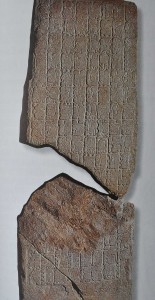 Did you know that the whole thing about the Mayan calendar predicting the end of the world in 2012 was based on one broken and eroded tablet of glyphs? The idea is that in the Mayan Long Count calendar, our current era (the 13-Bak’tun cycle) ends on the 21st of December 2012 and that this end date isn’t just the end of a historical era and the beginning of a new one, but rather the end of all eras. The sole reference to the 2012 apocalypse, however, is a highly nebulous line on a 1300-year-old stone tablet found in Monument 6 in the Tortuguero archaeological site in the southern state of Tabasco.
Did you know that the whole thing about the Mayan calendar predicting the end of the world in 2012 was based on one broken and eroded tablet of glyphs? The idea is that in the Mayan Long Count calendar, our current era (the 13-Bak’tun cycle) ends on the 21st of December 2012 and that this end date isn’t just the end of a historical era and the beginning of a new one, but rather the end of all eras. The sole reference to the 2012 apocalypse, however, is a highly nebulous line on a 1300-year-old stone tablet found in Monument 6 in the Tortuguero archaeological site in the southern state of Tabasco.
Mexico’s National Institute of Anthropology and History and Mayan experts in general have not been big fans of the Mayan apocalypse theory because they say it projects a Western obsession with eschatology onto Mayan culture. Nor have they found the various translations of that one line of hard to read glyphs particularly persuasive.
Or that’s what they said in public anyway. The Mexican government has been holding out on us, for the Tortuguero tablet is not the sole reference to 2012. There is a second one engraved on the face of one of the bricks in the nearby Comalcalco temple. (You can catch a glimpse of a Comalcalco brick in this news roundup of the story, but I’m not certain if it’s the One True Brick or just a representative.)
Arturo Mendez, a spokesman for the institute, said the fragment of inscription had been discovered years ago and has been subject to thorough study. It is not on display and is being kept in storage at the institute.
WHAT ARE THEY TRYING TO HIDE? Oh sure, a handful of scholars knew about this brick, but they’re obviously in on it.
[University of Texas at Austin Mayan epigraphy expert David] Stuart said the date inscribed on the brick “‘is a ‘Calendar Round,’ a combination of a day and month position that will repeat every 52 years.”
The brick date does coincide with the end of the 13th Baktun; Baktuns were roughly 394-year periods, and 13 was a significant, sacred number for the Mayas. The Mayan Long Count calendar begins in 3114 B.C., and the 13th Baktun ends around Dec. 21, 2012.
But the date on the brick could also correspond to similar dates in the past, Stuart said.“There’s no reason it couldn’t be also a date in ancient times, describing some important historical event in the Classic period. In fact, the third glyph on the brick seems to read as the verb huli, ‘he/she/it arrives,'” Stuart wrote. “There’s no future tense marking (unlike the Tortuguero phrase), which in my mind points more to the Comalcalco date being more historical than prophetic.”
A likely story, Mr. “Stuart”, if that’s your real name.
In order to continue to pull the wool over out eyes until it’s too late, the National Institute of Anthropology and History will hold a round table of 60 Mayan experts next week at the Palenque archaeological site where they will “explain” the Mayan Long Count calendar’s vision of historical cycles. Doubtless those 60 experts will be paid with third class berths on the top secret giant arks being built in underground shipyards to save the privileged few from the extinction of our species.